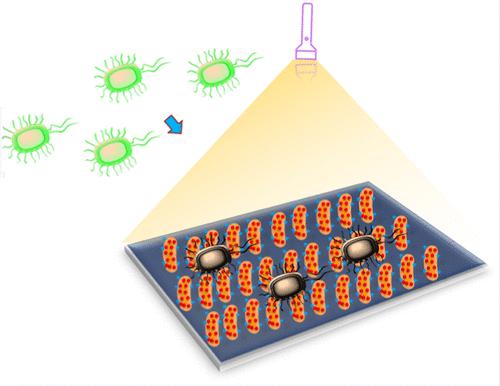当前位置:
X-MOL 学术
›
ACS Appl. Mater. Interfaces
›
论文详情
Our official English website, www.x-mol.net, welcomes your
feedback! (Note: you will need to create a separate account there.)
Biomimetic Bacterium-like Particles Loaded with Aggregation-Induced Emission Photosensitizers as Plasma Coatings for Implant-Associated Infections
ACS Applied Materials & Interfaces ( IF 8.3 ) Pub Date : 2024-04-05 , DOI: 10.1021/acsami.3c19484
Jianzhong Wang 1, 2 , Neethu Ninan 3 , Ngoc Huu Nguyen 3 , Manh Tuong Nguyen 3 , Resmarani Sahu 3 , Tien Thanh Nguyen 3 , Agnieszka Mierczynska-Vasilev 4 , Krasimir Vasilev 3 , Vi Khanh Truong 3 , Youhong Tang 1
ACS Applied Materials & Interfaces ( IF 8.3 ) Pub Date : 2024-04-05 , DOI: 10.1021/acsami.3c19484
Jianzhong Wang 1, 2 , Neethu Ninan 3 , Ngoc Huu Nguyen 3 , Manh Tuong Nguyen 3 , Resmarani Sahu 3 , Tien Thanh Nguyen 3 , Agnieszka Mierczynska-Vasilev 4 , Krasimir Vasilev 3 , Vi Khanh Truong 3 , Youhong Tang 1
Affiliation

|
Developing novel antibacterial strategies has become an urgent requisite to overcome the increasing pervasiveness of antimicrobial-resistant bacteria and the advent of biofilms. Aggregation-induced emission-based photosensitizers (AIE PSs) are promising candidates due to their unique photodynamic and photothermal properties. Bioengineering structure-inherent AIE PSs for developing thin film coatings is still an unexplored area in the field of nanoscience. We have adopted a synergistic approach combining plasma technology and AIE PS-based photodynamic therapy to develop coatings that can eradicate bacterial infections. Here, we loaded AIE PSs within biomimetic bacterium-like particles derived from a probiotic strain, Lactobacillus fermentum. These hybrid conjugates are then immobilized on polyoxazoline-coated substrates to develop a bioinspired coating to fight against implant-associated infections. These coatings could selectively kill Gram-positive and Gram-negative bacteria, but not damage mammalian cells. The mechanistic studies revealed that the coatings can generate reactive oxygen species that can rupture the bacterial cell membranes. The mRNA gene expression of proinflammatory cytokines confirmed that they can modulate infection-related immune responses. Thus, this nature-inspired design has opened a new avenue for the fabrication of a next-generation antibacterial coating to reduce infections and associated burdens.
中文翻译:

载有聚集诱导发射光敏剂的仿生细菌样颗粒作为用于植入相关感染的等离子体涂层
开发新型抗菌策略已成为克服日益普遍的耐药细菌和生物膜出现的迫切需要。聚集诱导发射光敏剂(AIE PS)因其独特的光动力和光热特性而成为有前途的候选者。用于开发薄膜涂层的生物工程结构固有的 AIE PS 仍然是纳米科学领域中一个尚未探索的领域。我们采用等离子体技术和基于 AIE PS 的光动力疗法相结合的协同方法来开发可以根除细菌感染的涂层。在这里,我们将 AIE PS 加载到源自益生菌菌株发酵乳杆菌的仿生细菌样颗粒中。然后将这些混合缀合物固定在聚恶唑啉涂层基材上,以开发仿生涂层来对抗植入物相关的感染。这些涂层可以选择性地杀死革兰氏阳性和革兰氏阴性细菌,但不会损害哺乳动物细胞。机理研究表明,涂层可以产生活性氧,从而破坏细菌细胞膜。促炎细胞因子的 mRNA 基因表达证实它们可以调节感染相关的免疫反应。因此,这种受自然启发的设计为制造下一代抗菌涂层以减少感染和相关负担开辟了一条新途径。
更新日期:2024-04-05
中文翻译:

载有聚集诱导发射光敏剂的仿生细菌样颗粒作为用于植入相关感染的等离子体涂层
开发新型抗菌策略已成为克服日益普遍的耐药细菌和生物膜出现的迫切需要。聚集诱导发射光敏剂(AIE PS)因其独特的光动力和光热特性而成为有前途的候选者。用于开发薄膜涂层的生物工程结构固有的 AIE PS 仍然是纳米科学领域中一个尚未探索的领域。我们采用等离子体技术和基于 AIE PS 的光动力疗法相结合的协同方法来开发可以根除细菌感染的涂层。在这里,我们将 AIE PS 加载到源自益生菌菌株发酵乳杆菌的仿生细菌样颗粒中。然后将这些混合缀合物固定在聚恶唑啉涂层基材上,以开发仿生涂层来对抗植入物相关的感染。这些涂层可以选择性地杀死革兰氏阳性和革兰氏阴性细菌,但不会损害哺乳动物细胞。机理研究表明,涂层可以产生活性氧,从而破坏细菌细胞膜。促炎细胞因子的 mRNA 基因表达证实它们可以调节感染相关的免疫反应。因此,这种受自然启发的设计为制造下一代抗菌涂层以减少感染和相关负担开辟了一条新途径。

































 京公网安备 11010802027423号
京公网安备 11010802027423号